Viking Sea
Viking Cruise Lines is a comparatively new company. Their ships are flagged in Norway, though the company headquarters is in Switzerland. Viking offers trips on various rivers in Europe, as well as ocean-going cruises. We have done two of the latter, one in the Baltic Sea, and most recently in the Mediterranean Sea.
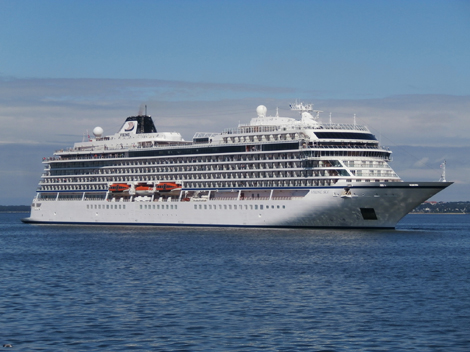
Viking's ocean ships are all built in the same shipyard in Italy to a more-or-less standardized pattern. This trip we were in Viking Sea; in the Baltic we were in Viking Sky, shown here. All of their ship names start with "Viking," even the river cruisers. These ocean ships are of considerable size, though much smaller than QM2, perhaps two-thirds as big at "only" 748 feet in length and displacing 47,000+ tons. We encountered another sister, Viking Jupiter in Barcelona. Without seeing the name on the bow it's hard to tell any of these ships apart. Viking's ocean vessels are regarded as "small ships" in the travel business, and compared to the monsters discussed above, indeed they are: only 930 passengers.
Viking Sea and her sisters are very different in "style" to QM2. They're very "Nordic," which seems appropriate. Light-colored wood, large open public spaces, and trim lines. If QM2 is somewhat of a British dowager in style, Viking's ships are young, sleek Scandinavian beauties. Viking Sea is, of course, a cruiser, but pretty enough that I can forgive her for being one. She's not the sort of butt-ugly tub most big cruisers are.
Viking's approach to cruising differs from that of the bigger ships and cruise lines. For one thing, there are no children on board nor do their ships have casinos (something that is de rigeur aboard typical cruisers). If Cunard is marketing "comfortable elegance" (as exemplified by QM2 ) Viking's pushing "education and enrichment." To this end their program always includes a "port talk" to highlight the history and culture of the place that's next on the itinerary. Viking's ships also have resident classical musicians: a string trio and a classical pianist play nightly in the large and airy atrium. They do offer nightly entertainment as well.
Comparisons and Contrasts of Amenities
In nearly all respects with the differences noted above there is little to choose between the our ships. I say "nearly all" because there are some things in which they do differ. To start with, both ships offer verandah staterooms: but we opted for an "inside" room in QM2 (i.e., one with no view because it was cheaper and my wife is prone to motion sickness when she watches water rushing past) but aboard Viking Sea there are only verandahs, so she just didn't look out except when we were in port.
Although QM2 's food is very good, in my opinion, the food aboard Viking Sea was a notch or two better. QM2 has a regrettable tendency to serve meat with sauces that don't always enhance the inherent flavors. I will also add, I'm sorry to say, that the steak I was served in QM2 was tough and—to my taste—overcooked. QM2 serves meats either "medium" or "well done" and there are no other options for those of us who prefer "medium rare." I have wondered whether this is some sort of reflection of the ship's essentially British nature, but it was mildly annoying. Well, at least it wasn't boiled. Viking Sea's steaks, by contrast, were always perfectly cooked and quite tender. A small point perhaps, but to this carnivore, one that was significant.
QM2 did serve some dishes that wouldn't be found in a less-traditionally-British vessel. Quite a few lamb dishes; several times they offered venison, and once, pheasant. On that night's dinner menu a small-print notation informed the diner that the pheasant "May contain small shots." A lady at our table asked what that might mean: I explained to her that in Britain pheasant are raised and released on large estates to be shot by people who pay big bucks for the privilege. Shooting is a very high-dollar activity so it's a significant source of income for these estates.
While it's illegal in the USA to sell wild game, in the UK there is no such prohibition. Game birds (and animals such as deer) taken on these estates are sold to wholesalers, who in turn retail them to restaurants, supermarkets, and purchasers such as Cunard. The small warning on the menu was to alert diners that yes, while Cunard no doubt takes care to remove them, there can be no guarantee that there might not be a bit of birdshot left behind here and there. It would be very difficult to be absolutely certain they had all been found. She cringed and ordered something else. I ordered the pheasant—sans shot, I hasten to add—which was very good. (If you want to see how this is done, and how to cook the birds, click here. This PBS video was made at a Virginia property where I've shot many a pheasant myself.)
Viking Sea's menus were slightly more conventional. I'd been hoping for reindeer at least, but it was not to be. Lamb yes, but reindeer, let alone polar bear or seal, wasn't on offer. To make up for it, in the Explorer's Lounge they did have reindeer pelts on the couches. In Norway some years ago I had the opportunity to eat whale meat, but neither was that on the menu in Viking Sea. Just as well.
Both QM2 and Viking Sea provide two "alternative dining" options. One of these is the inevitable Italian restaurant. In QM2 there is also a steakhouse, but in Viking Sea the second is a prix fixeé menu decided upon by the chef. We didn't try alternative dining in QM2 because there was a substantial additional charge for either venue. In Viking Sea reservations were needed but there was no up-charge for the options, so we went to both of them.
This brings up another point: QM2 charges for any sort of drinks (including soft drinks) other than water and coffee with meals. Viking Sea includes beer and wine with lunch and dinner in the price of the passage. QM2 tends to charge extra for everything except passage. I found this annoying, given the price of a ticket. Granted Viking charges more but QM2 charges enough that they could easily have included a glass of wine with meals without hurting Cunard's bottom line.
Viking's ships are somewhat less formal than QM2. Aboard the Cunarders there are two "gala nights" in each week-long crossing, when passengers are encouraged to dress to the nines. Many do, too. Men often wear tuxes and ladies long gowns but neither is mandatory. A jacket and a tie suffice for men. QM2 requires what they term "smart attire" after 6:00 PM, which they define rather liberally as meaning that men's shirts must have collars and ladies should wear skirts or trouser suits. Ties are not required (as my wife has pointed out, nowadays men have rebelled, more or less successfully, against wearing neckties) but wearing one brings a smile of approval from the stiff-necked headwaiter in the Britannia Restaurant.
Viking Sea is much more relaxed. They do assert that "...blue jeans are not acceptable in the restaurant..." (a sentiment with which I'm in whole-hearted agreement). So far as I could tell that was really the only rule in effect. The first night we went to dinner, however, the man in line in front of me was wearing jeans: the headwaiter politely pointed out this faux pas, but did not—as he should have done—send that transgressor to change his trousers or go up to the informal buffet instead.
The Crews
In both ships nearly all the "visible" crew members—i.e., dining room and cleaning staff whom we encountered every day—were Asian, with one or two exceptions. Most of them seemed to have come from the Philippines. One of the exceptions was the barber who cut my hair soon after we boarded in New York. He was from....Madagascar. To the best of my knowledge he is the only Malagasy (that's the word for someone from Madagascar) I have ever met.
The entertainment staff in both ships typically weren't Asian, though. In QM2 they were all British. In Viking Sea they were Westerners, including a very, very talented Entertainment Director from, of all places, North Carolina.
Over The Semi-Bounding Main
John Maxtone-Graham's book The Only Way To Cross opens with this ominous sentence: "The North Atlantic is the most dangerous ocean in the World." QM2 has carried me across four times without incident and I hope that will always be the case. I don't have any desire to test the veracity of that declaration, but it's certainly supported by history.
There's an ironic saying that one description of seasickness is that "You think you're going to die and you're afraid you won't." Even big ships like QM2 are affected by bad weather and rough seas but the bigger the vessel the less she is moved by the sea. We like to get a cabin close to the center of the vessel, where motion is least pronounced. We've been lucky so far: three times we've been on Deck 4 more or less midships; we hardly felt any movement at all. However, this time on our return to New York we were in a cabin on Deck 5 well up in the bows, where there was detectable movement, mainly pitching. Nothing worrying, but it was there. We had originally been booked into a cabin on Deck 10, where doubtless the motion would have been far more pronounced. In point of fact we experienced far more movement in Viking Sea sailing the Mediterranean Sea. This was probably due to a combination of factors: the sea was a bit rough, and the ship substantially smaller than QM2. I'm happy to say I'm not prone to motion sickness, but my wife is. A scopolamine patch prevented any issues for her.
The Passengers
Back in the days before air travel killed off the ocean liners, the passenger mix would have been very different from that of today. If you had business to transact across The Pond, or if you were on vacation to Europe, well, if it took a week (or longer) to arrive and another week to return, that's what it took. There was no other way. Hence businessmen, students, vacationing families, and others simply made time in their schedules to travel. But fast, cheap air travel changed things. People today are usually in a hurry; they don't fancy "wasting" a week to get to England and another to return, on top of whatever they plan to do there. The airlines took advantage of this desire to go ever faster by coining a brilliant advertising slogan: "If you've no time to spare...go by air." And it worked, far better than the shipping companies' retort that "Getting there is half the fun! " did, though the latter statement is absolutely true.
Beginning in the late 1950's air travel began to overtake transatlantic ocean transit. The first long-distance passenger jet, the Boeing 707, cut the travel time from 7 days to 7 hours or so. That was the death knell for the great ships. In 1966 I made my first trip to Europe in a 707; by 1969 nearly all the liners were gone, including the greatest one of all, S.S. United States. She had set the speed record across in 1953 on her maiden voyage, at 3 days, 10 hours, and 40 minutes. But she was no longer economically feasible to run and she shut down her boilers for the last time in 1969. Today after decades moored and immobile she is on her way to become an "artificial reef" off the coast of Florida, a fate almost as ignominious as being broken up for scrap.
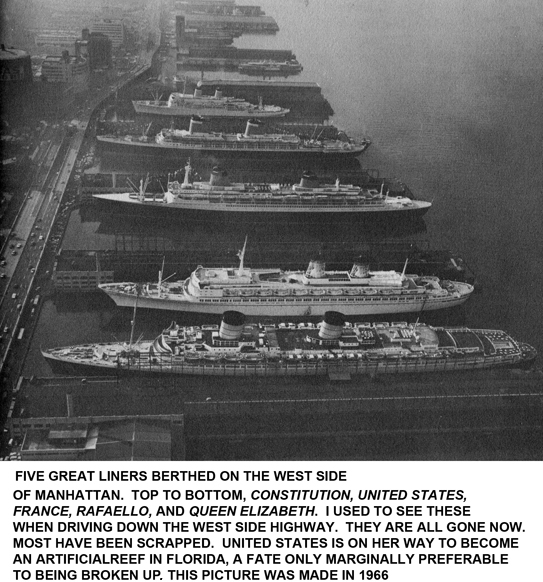
Today the average passenger in QM2 or the Viking ocean ships is an affluent retiree with an average age of about 70+. We Geezers have the time and the money to cross The Pond the old-fashioned way. The 20-Somethings and middle-aged business travelers are gone, nor do they even think about going by ship.
One interesting thing we noticed was that some people have a very special reason for crossing in QM2: dogs. She has kennels on board. We encountered a few people (military and/or State Department employees) rotating home who chose to travel in her because they could bring their dogs along rather than subject them to the dangers of air travel or worse, leave them behind. Some people also were traveling with service dogs. Canine transatlantic transport is a unique service only QM2 can provide. Viking doesn't do this, nor for that matter do the other Cunard Queens. Just QM2.
The Trips
Across The Pond and back were pretty straightforward, so I won't bother to describe them again: I did that in another essay. The Viking cruise was actually the purpose of going over in the first place.
We always take AMTRAK (sigh...) to and from New York for these crossings. AMTRAK is a bottomless money pit, to the tune of $1.5 BILLION per year, more or less. Why people think that resurrecting a 19th-Century transportation modality in the 21st is a good idea I will never understand. Perhaps some people like jolting discomfort, stuffy (alternatively, freezing) coaches, smelly toilets, bad and overpriced snacks masquerading as "food," and the thrill of thundering through the kudzu at 35 MPH for hours on end, but I'm not one of them and I'm not the only one. It's 10 hours each way from Roanoke to New York, if the train runs on time, which it usually doesn't. I am outraged by the fact that for one-third of what is poured down the AMTRAK rat-hole every year S.S. United States could be restored to pristine condition and put back in service...but enough of the anti-AMTRAK rant.
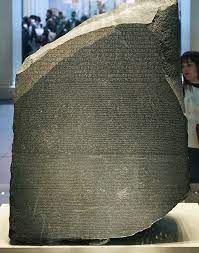 First Stop, Southampton to London
First Stop, Southampton to London
QM2 docks in Southampton very early in the morning. Trains leave from there on an hourly basis and take you into Waterloo Station. British trains vary in comfort but the hourly service to London is on the Great Western Railway, one of the better services. The GWR took us to Waterloo Station, a huge place with thousands of polite people milling about proving that the British really use their extensive railroad system. From there we took one of those wonderful English "Black Cabs" to our hotel.
We spent a couple of days in London with two sightseeing objectives: the British Museum and Hampton Court Palace. At the Museum we wanted to see the Rosetta Stone and the Elgin Marbles. The first, as everyone knows, was the key to reading ancient Egyptian hieroglyphics so that archeologists could decide who was buried in which tomb in the Valley of the Kings. It's also now the trade name for a series of language-learning CD's. We sort of did get to see the Stone: to get a clear view of it we'd have had to shove aside about 3000 Chinese tourists, but we did see it edge on.
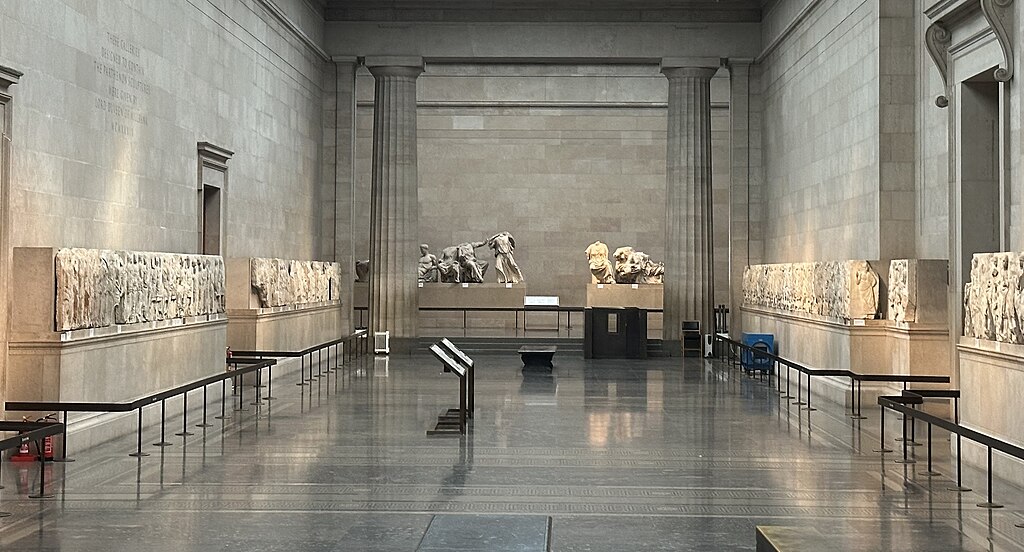
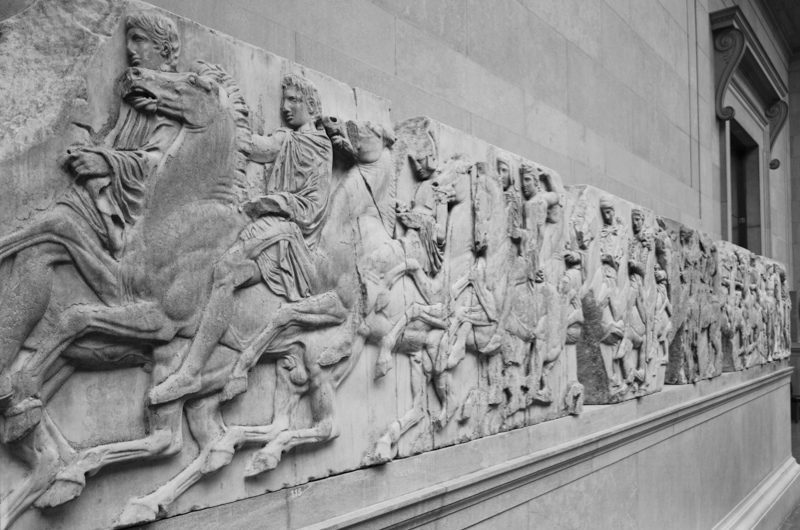
The Elgin Marbles are a collection of elements removed from the frieze around the Parthenon in ancient Greece. For reasons incomprehensible to me Lord Elgin, the British Ambassador to the Ottoman Empire in the early 19th century, decided he wanted to bring them back to Britain and put them on display. To this day there is an ongoing argument about whether he bought them from the Ottoman Empire or simply stole them, but whichever is the case, they're in London now and the prospect of their return is dim. If you're into sculpture, especially damaged sculpture, these items are a must-see. Most of these "priceless" objects are badly damaged, but I suppose Lord Elgin felt that was irrelevant. According to the captions provided by the Museum he had a lot of assistance from the Royal Navy to hoist this stuff on board ships and bring it back.
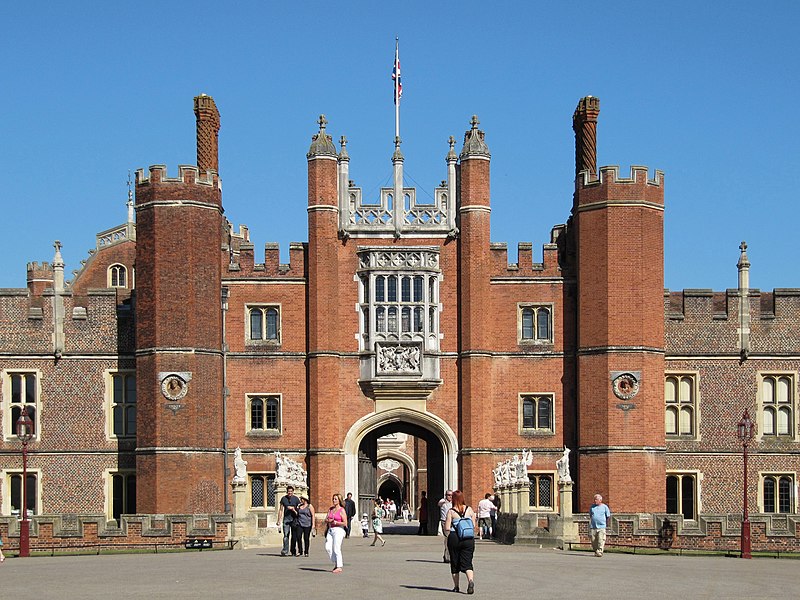
Another item on the Britain bucket list was Hampton Court Palace, a favorite playground of that noted gourmand and barbaric tyrant, Henry VIII. It had originally been built by Cardinal Thomas Wolsey, one of Henry's most trusted and powerful advisors. He "gifted" it to King Henry in hopes of convincing the King not to have him killed because he failed to convince the Pope to grant Henry's request for a divorce from Catherine of Aragon. Fat lot of good it did him: he was stripped of his property and offices and arrested anyway. He did however manage to die on his own terms, of dysentery. The palace is a colossal complex of buildings, not all of which date from Tudor times: King William III had it substantially modified, by tearing half of it down and building more on to replace what he'd had demolished. Lots of Tudor-era stuff including a huge set of kitchens and a toilet or two. We didn't see King William's toilet, which may have been only marginally better than Henry VIII's. It is obviously a world-wide attraction, as the sign below, in the train station, attests:
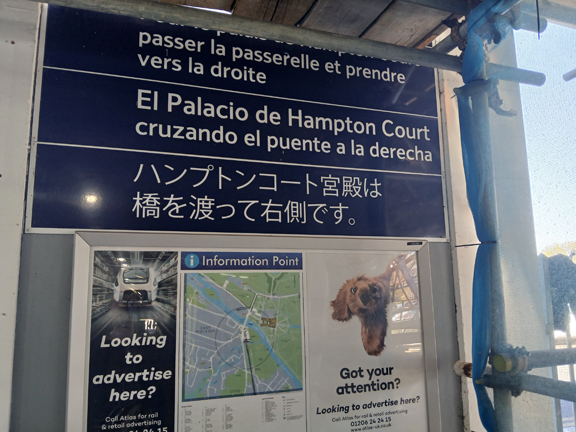
Next Stop, Paris
In London we stayed at a Premier Inn hotel near St Pancras rail station. We like the Premier Inn chain: very basic places but clean, reasonably priced (for Europe, anyway) and conveniently located. We needed to be near St Pancras because that's from whence the Eurostar train to the Continent leaves.
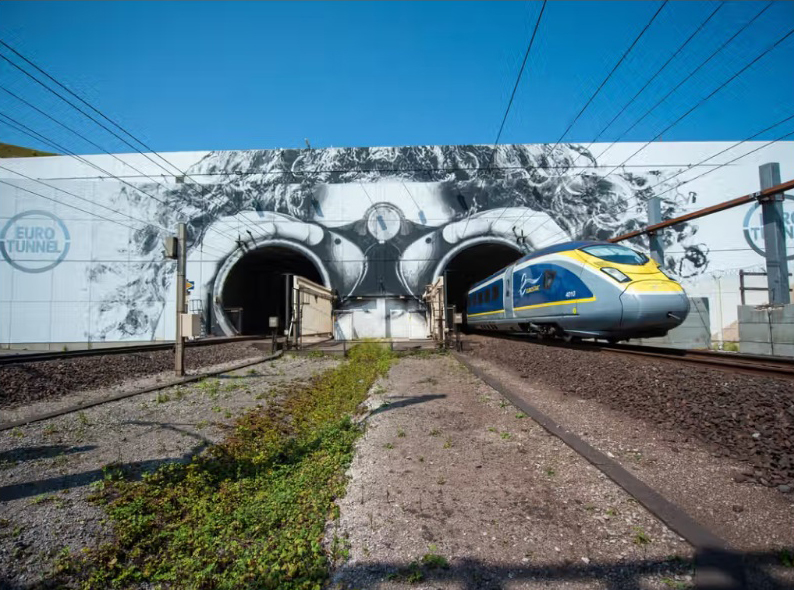
The Channel Tunnel (or "Chunell") is the direct link: trains leave regularly from St Pancras and stop in various cities on the Continent, the first of these being Paris. You are dropped off at the Gare du Nord, more or less centrally located.
Boarding the Eurostar is a bit more complicated than it used to be, back in the days before Brexit. Now, the "border" between the UK and France is in the St Pancras station. First you need to "leave" the UK, which entails a long wait in an incredibly crowded waiting room, then passing through security and passport control. Some 20 feet away, you have to go through French passport control, plus more security to "enter" "France" in St Pancras.
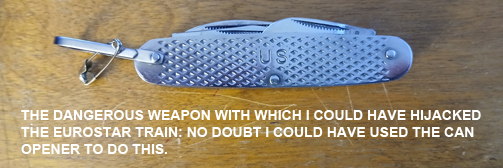 The security people are incredibly strict. I routinely carry a small pocket knife, but I'm not crazy enough to carry it onto an airplane in my pocket, so I stick it into my checked bag. On airlines this works well, but the security guy at St Pancras spotted it on an X-ray, and said to me, with a menacing tone, "Do you have a KNIFE in there?" Well, yes, I did. He wanted to see it. I started to dig around in the suitcase, explaining that it was folding pocket knife with a 2-inch blade: he asked me if it was a "fixed blade," which it most decidedly is not. After rummaging around for a while he decided to be magnanimous and allowed me to board the train with this incredibly menacing weapon still in my suitcase. This incident was very nearly as stupid as the time Air Canada confiscated a corkscrew (I had one of those too but the security guy seemed not to care about that). In any event, I was allowed on board and off to Gay Paree. Once there we took a taxi to our hotel. A few years ago we had made plans through our regular travel agent, who booked us into the Hotel D'Espagne.
The security people are incredibly strict. I routinely carry a small pocket knife, but I'm not crazy enough to carry it onto an airplane in my pocket, so I stick it into my checked bag. On airlines this works well, but the security guy at St Pancras spotted it on an X-ray, and said to me, with a menacing tone, "Do you have a KNIFE in there?" Well, yes, I did. He wanted to see it. I started to dig around in the suitcase, explaining that it was folding pocket knife with a 2-inch blade: he asked me if it was a "fixed blade," which it most decidedly is not. After rummaging around for a while he decided to be magnanimous and allowed me to board the train with this incredibly menacing weapon still in my suitcase. This incident was very nearly as stupid as the time Air Canada confiscated a corkscrew (I had one of those too but the security guy seemed not to care about that). In any event, I was allowed on board and off to Gay Paree. Once there we took a taxi to our hotel. A few years ago we had made plans through our regular travel agent, who booked us into the Hotel D'Espagne.
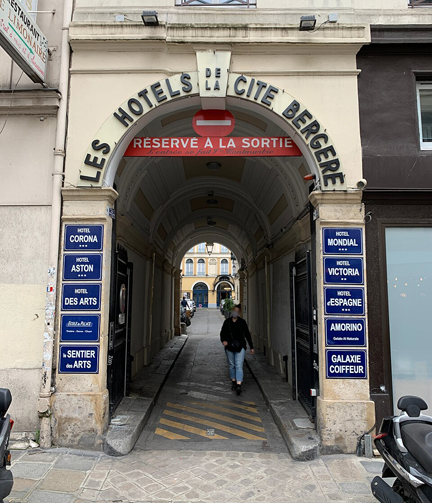
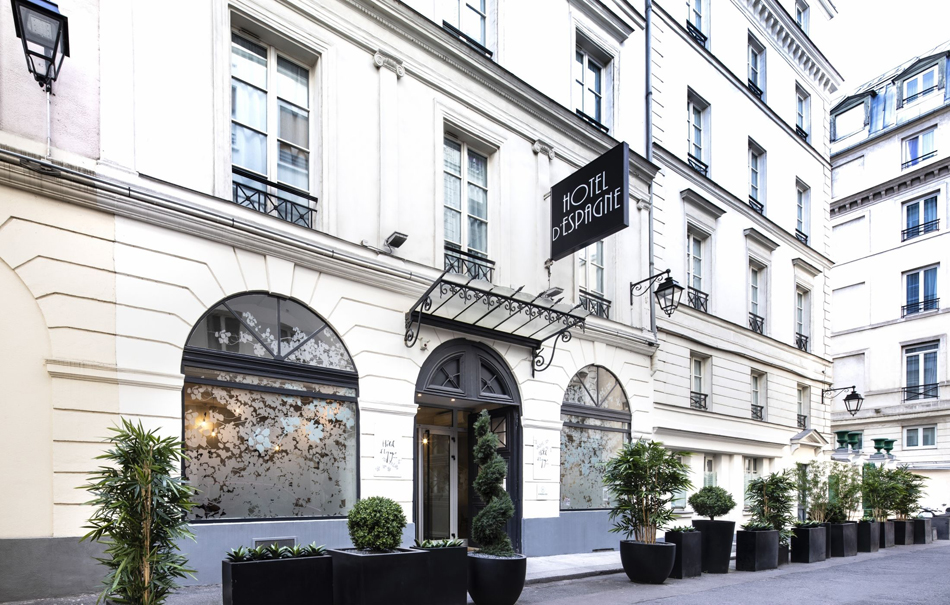
This little gem of a hotel is one of several located in a sort of an arcade between two main streets. Main streets in central Paris are incredibly noisy because the French seem to like big, fast, LOUD motorcycles to go with all the other sources of street noise. But the "Cité Bergère" is amazingly quiet. Even better, at one end the arcade leads to a street in which is located...a laundry. One of the banes of travel is the very limited opportunities to wash clothes. QM2 has launderettes but they're always "booked up" with people standing in line to use the few machines available. At that point we'd been traveling for two weeks so this laundry 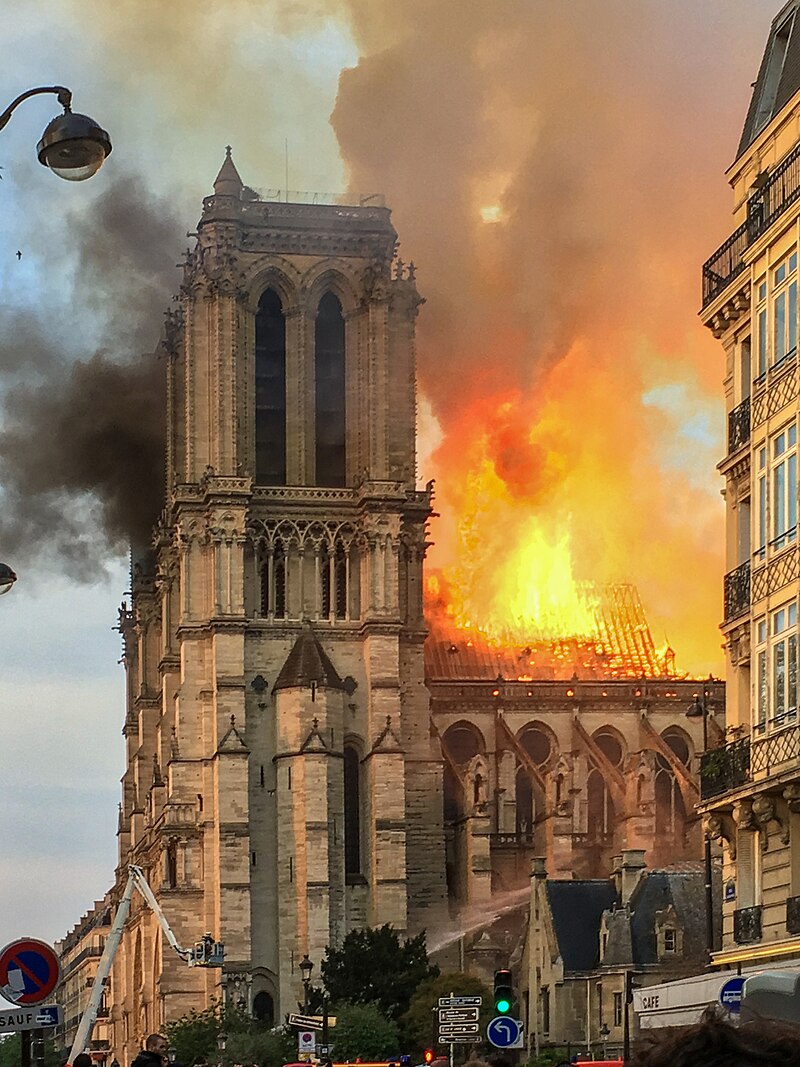 was a Godsend. We dropped off our clothes ("Non self-service, Monsieur !") and were able to pick them up the next day.
was a Godsend. We dropped off our clothes ("Non self-service, Monsieur !") and were able to pick them up the next day.
We had two objectives in Paris: the first was to see Notre-Dame cathedral after its near-miraculous post-fire restoration. We had been to Notre-Dame in 2018, shortly before the fire destroyed the roof in its entirety and threatened to bring the entire cathedral down. Mercifully it was caught in time but the damage was extensive: like all such medieval cathedrals the roof was sheathed in lead: molten lead isn't a great thing to have dropping on the interior of a 12th Century building. Lead dust coated everything that didn't burn. Priceless art works had been removed at great risk. The huge organ needed extensive repair and rebuilding, but the cathedral building survived, and was restored thanks to the work of five years on the part of thousands of people. The interior stonework has been cleaned for the first time in centuries, the paintings and stained glass windows have been restored, and the cathedral is set to go for another 1000 years. The rebuilding included modifications to prevent new fires: the 2019 fire started when workmen ignited some dry wood in the ancient ceiling.
The second Paris objective was to get to the top of the Eiffel Tower. We'd seen a documentary on its construction and history; my wife was determined to go up as far as we could. We'd been able to get to the first stage one time, years ago, but last trip the lines were too long. This time we were able to go up after only an hour and a half's wait!
On To Barcelona By Air
Okay, London and Paris done, it was time to go to Spain, specifically Barcelona, because that's where the Viking cruise started. My wife had long wanted to see Barcelona, but I'd never been there; or for that matter, Spain at all. (Well, I was, sort of, in Spain. In 1973 while I was in the Air Force, the C-130 in which I was traveling made a crew rest stop at Las Palmas, in the Canary Islands. This is Spanish territory, so I guess I could say I'd been to "Spain," but that didn't really count.) Barcelona is major tourist destination about which everyone raves.
We were booked on a budget airline out of Charles de Gaulle airport. A very bare-bones flight, with no amenities and seats that were so close together that even I, as short as I am, felt cramped. I can't imagine what a taller person might experience. But it got us to Barcelona on time, whence were were met by a driver our travel agent had arranged for us. He was very chatty, telling us a lot of history of the city; after a while we stopped listening. Our travel agent had booked us into a very nice hotel on the main tourist street. Every third street in Barcelona is named "Rambla Something," but "Rambla Catalunya" is the principal one, the epicenter of the tourist trade. The room wasn't ready when we arrived so we had coffee in their lounge. The hotel was part of the H10 Hotel chain, the H10 Metropolitan Rambla Catalunya, located within walking distance of most of the things we wanted to see, and taxi distance of the rest. We were within a few blocks of the port. Along the way we encountered hordes of tourists: battalions of them, trooping up and down among the innumerable restaurants, junque shops, bars, and kiosks. Some of these kiosks sold the usual crap—99% of it made in China—but some had a few unique items, including seeds for what can only be termed "X-rated" plants. I imagine these sold well.
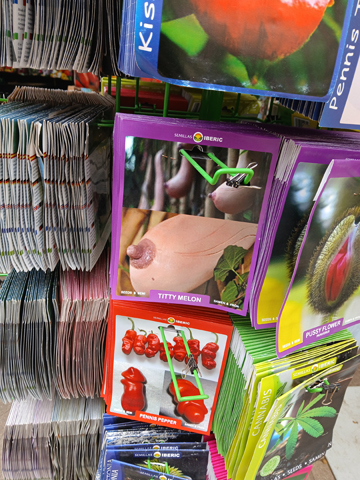

We were there before the main tourist season had really begun: what it must be like when that starts is hard to imagine. We've heard stories about locals squirting tourists with water pistols to demonstrate their displeasure with the vast numbers of foreigners flooding the streets, and I can understand why that might happen. It didn't happen to us.
The Basilica Sagrada Familia
Once we finally got into our room, the first order of business was to go to the one place in Barcelona that everyone is required—perhaps by law, but certainly by the solemn advice of the tour books—to see. It cannot be avoided, no matter how you try. This is the Basilica Sagrada Familia.
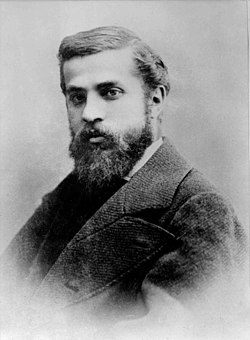 When you go to Europe you visit cathedrals. We have visited so many cathedrals I've long since lost count, but the Basilica Sagrada Familia takes the cake. It is, without doubt, the ugliest cathedral—heck, the ugliest building—I have ever seen, and am ever likely to see.
When you go to Europe you visit cathedrals. We have visited so many cathedrals I've long since lost count, but the Basilica Sagrada Familia takes the cake. It is, without doubt, the ugliest cathedral—heck, the ugliest building—I have ever seen, and am ever likely to see.
Now, that statement is tantamount to heresy. It would get me burned at the stake in Spain: everyone is required to admire this place, the product of the phantasmagorical imagination of the architect, Anton Gaudi (1852-1926). You will find this statement about him on the Internet:
Antoni Gaudí i Cornet was a Catalan architect and designer who pioneered the Catalan Modernist style of architecture. His work is known for its unique style and is considered an exceptional contribution to modern architecture.
I'll agree on that "unique style" statement. Nothing short of Martian architecture could be more unique. His work is characterized by endless floral curlicues, innumerable
decorative motifs that seem never to repeat themselves but simply to become more and more complicated, and the use of colors that have never been seen in the natural world. Perhaps his name wasn't the origin of the word "gaudy," but that word hardly begins to describe his work. He considered the Basilica to be his life's work, his main achievement (though he died before it was more than half completed). He is, in fact, buried there. He died in a street accident, run over by a tram; he's on his way to becoming a Roman Catholic saint, courtesy of the late Pope Francis.
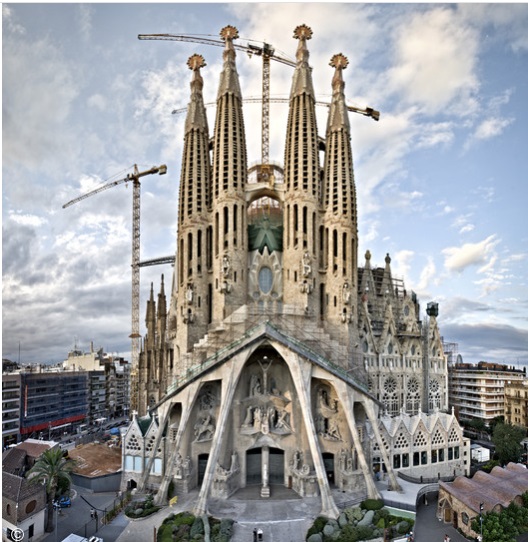
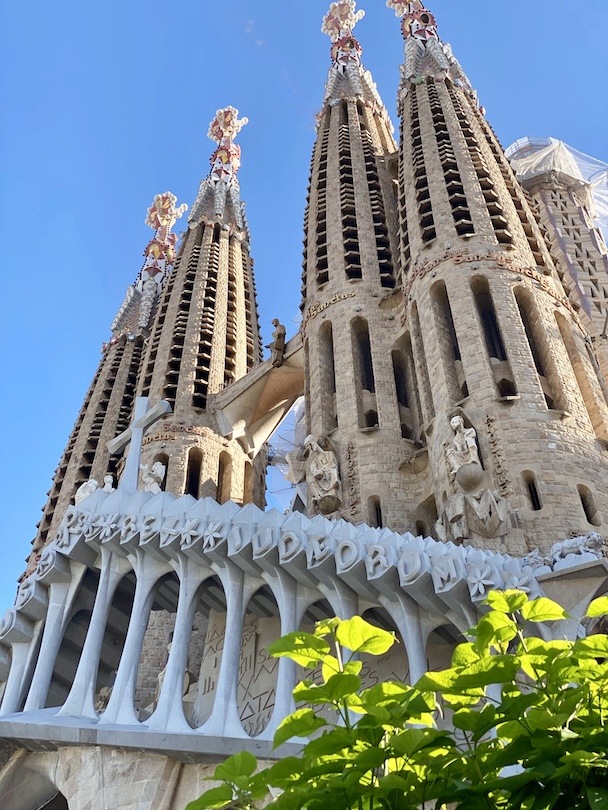
We went up in one of the towers of the basilica. Going up was no problem: there was an elevator. Coming down was. We had to walk down, on narrow triangular circular stairs, with no guard rails. For a couple of geezers this was no mean feat: there were people behind us who obviously were wishing we'd move faster but for us to do so would have presented a major risk of falling. Falling several dozen meters on stone. Likely we'd not have come home. At least not intact.
That was a long day, at the end of which I felt I'd earned a decent dinner, especially after that harrowing descent on the stairs of the basilica. We asked the concierge to recommend a few restaurants, including one that served good paella. He did us proud on that, giving us the name of a place called "Gaudim," within easy walking distance. They did serve paella, along with some very nice wine. The meals we had in Barcelona were all pretty good but Gaudim's was outstanding.
Another place he recommended, "Onofre," was unpretentious, serving some unusual tapas. I ordered razor clams, among others. These weren't like the ones I'd had in Seattle years ago. Those were fairly large, but the ones at Onofre were skinny tubes maybe half a centimeter in diameter.
Other meals we had in Barcelona—with the exception of the very nice breakfasts in the hotel—were okay but nothing special. Most of these were eaten in places on the Rambla Catalunya. One of these restaurants was notable not for the food but for the fact that it had robot waiters. You placed your order with a human but it was brought to you by a robot on wheels. Maybe this is a foreshadowing of things to come in the restaurant industry.
On return to the hotel we called Viking to inquire about our boarding time and stateroom number, what pier, how we got a boarding pass, etc. Cunard issues passes two weeks before boarding, but Viking is much more casual: we got them at the port as we were about to board just by showing them our passport. Same rigmarole with getting our pictures taken and being issued "boarding cards" we had to show when getting off and back on, but much less of a foo-fah than Cunard insists upon.
The next day we went to two other Gaudi buildings. One was an apartment house, Casa Batlló. The other was La Pedrera. These buildings were, if anything, even uglier than the cathedral. Casa Batlló is considered a "masterpiece," so I suppose, if everyone else thinks it is, it must be. Call me a Philistine if you will, but I really think this Modernisme stuff is highly over-rated. I may be the only person who thinks this way and who doesn't think Gaudi was some sort of unmatched genius, but there it is: "I yam what I yam and that's all what I yam," as Popeye said. Yer pays yer money and yer takes yer choice.
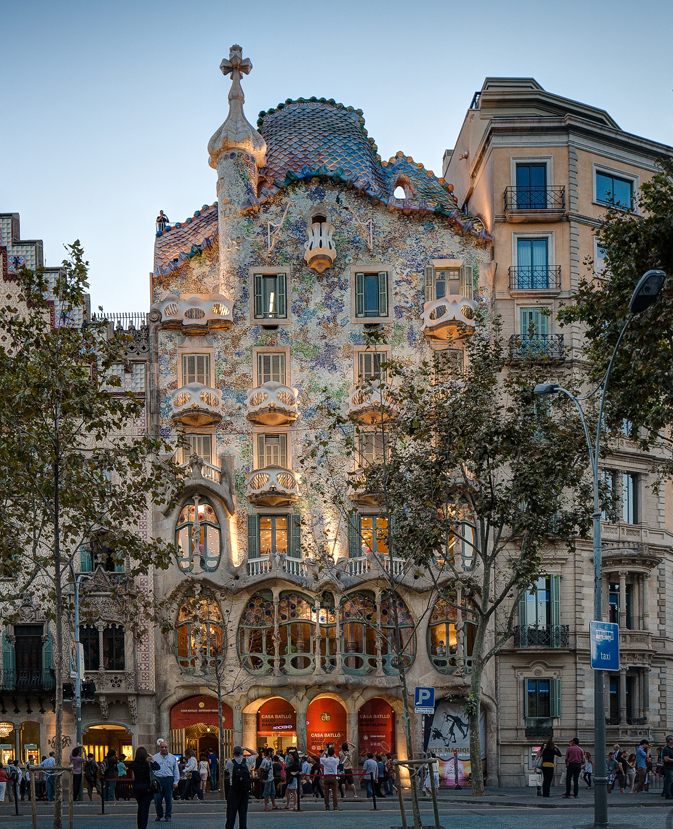
Casa Batlló
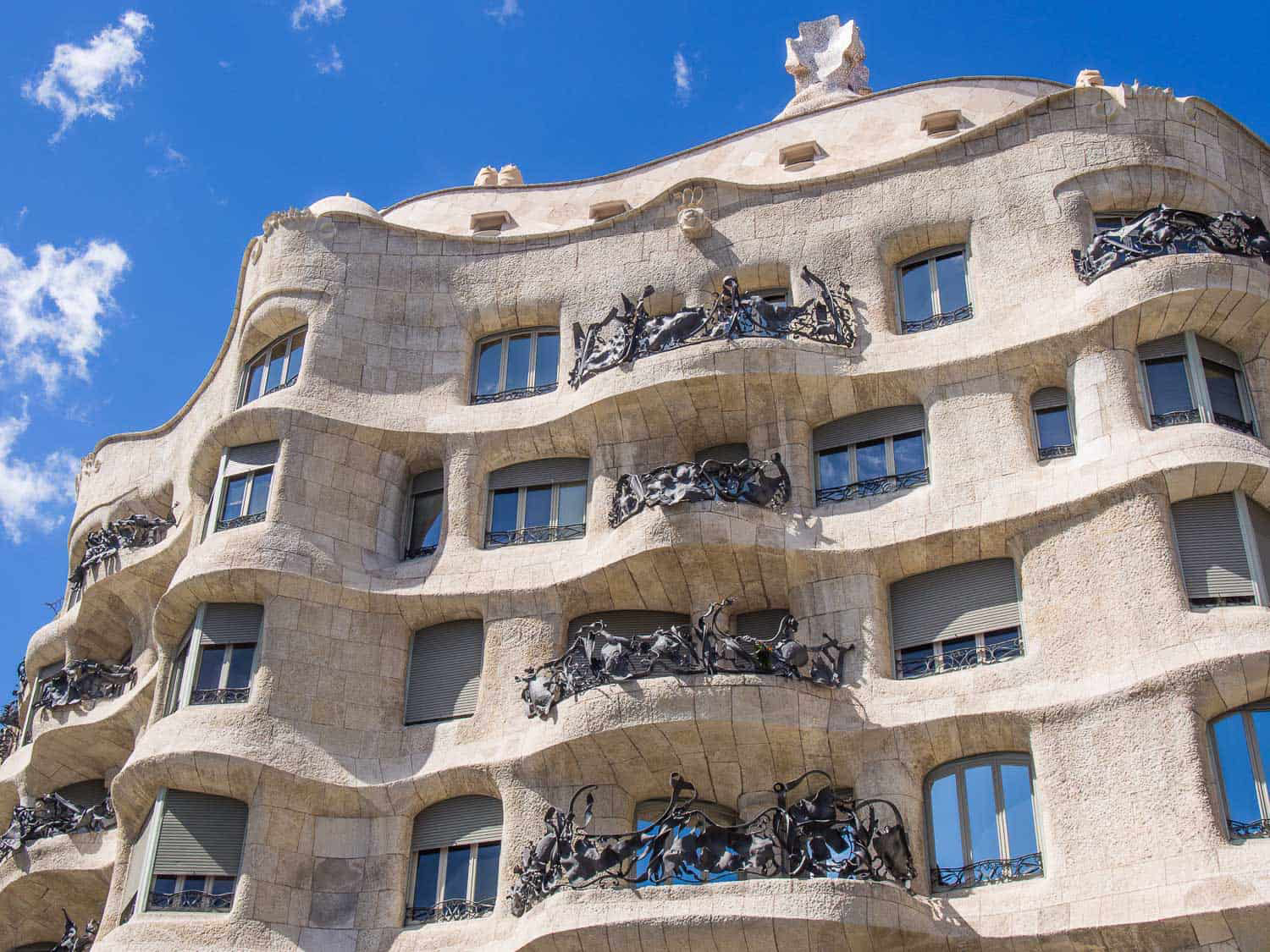
La Perdrera
Later that day we shoved our way through the crowds on the Rambla Catalunya to the harbor and spent a quiet couple of hours at the Maritime Museum. I'm "into" ships and this was a big draw for me. Moreover it wasn't crowded at all. The vast herds of people buying junk on the main drag weren't interested nor were they there, which suited me just fine. God knows, there is plenty of junk to be bought on the Rambla Catalunya.
The following day we went up to a park of sorts, Mont Juic, an old fort built to defend the harbor in the 18th Century. It was fitted with some formidable guns even then, and now there are very large (disabled) more modern ones, dating from the Spanish Civil War there. Barcelona is a major port, but it's not just for cruise ships. There's a huge container port as well: clearly a vast amount of commercial shipping runs through it. From this height we could see one of Viking's ships moored. It wasn't ours, it was her identical sister, Viking Jupiter but without being able to read the name we didn't know that.
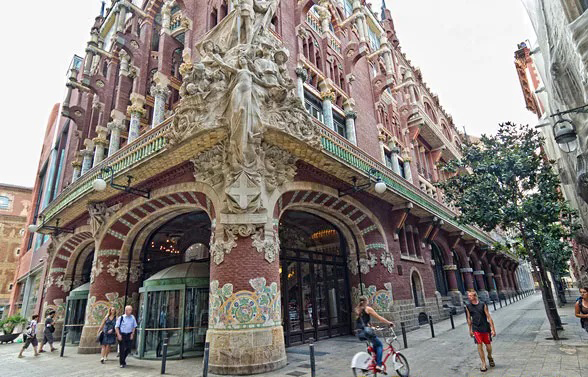
That evening we attended a flamenco show at the Catalan Palace of Music, a glitzy place of a vastly different style than Gaudi's architecture. It is what my late mother would have described by the Yiddish word ungapatchka, meaning overly ornate. The show itself was terrific. Flamenco isn't part of Catalan culture, being much more strongly associated with other parts of Spain; but it has its adherents all over the country. This was one of the high points of Barcelona. Flamenco is passionate and fiery, a dance style that's percussive and melancholic, but riveting in its nature. Flamenco includes guitar (in this show, augmented with other instruments), song, and rhythmic clapping. A very powerful and intriguing experience.
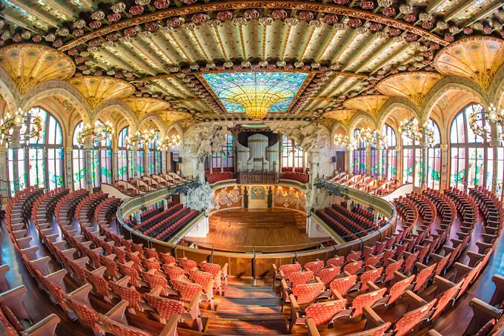
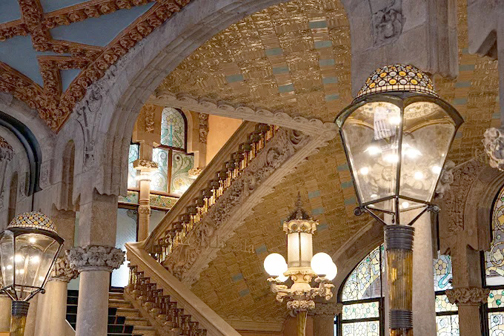
Then it was time to board Viking Sea. Barcelona is the biggest cruise port in the Mediterranean, serving many different lines. In Barcelona she was moored behind the 6500+-passenger Costa Toscana.
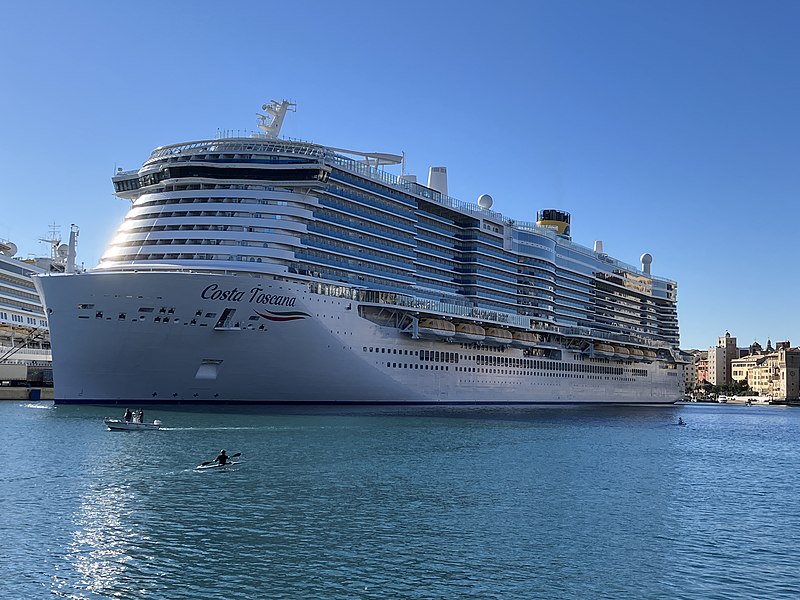
By the way, this monster that resembles a floating apartment building is not the biggest cruise ship in the world. That dubious distinction belongs to Star of the Seas, shown below in all her Las Vegas-style gaudiness. She might perhaps be better named Behemoth of the Seas: 248,000 Gross Registered Tons, and topping out at 7600 passengers. Add in the crew of 2350 and she has a population larger than most towns (and a few cities) in Virginia.
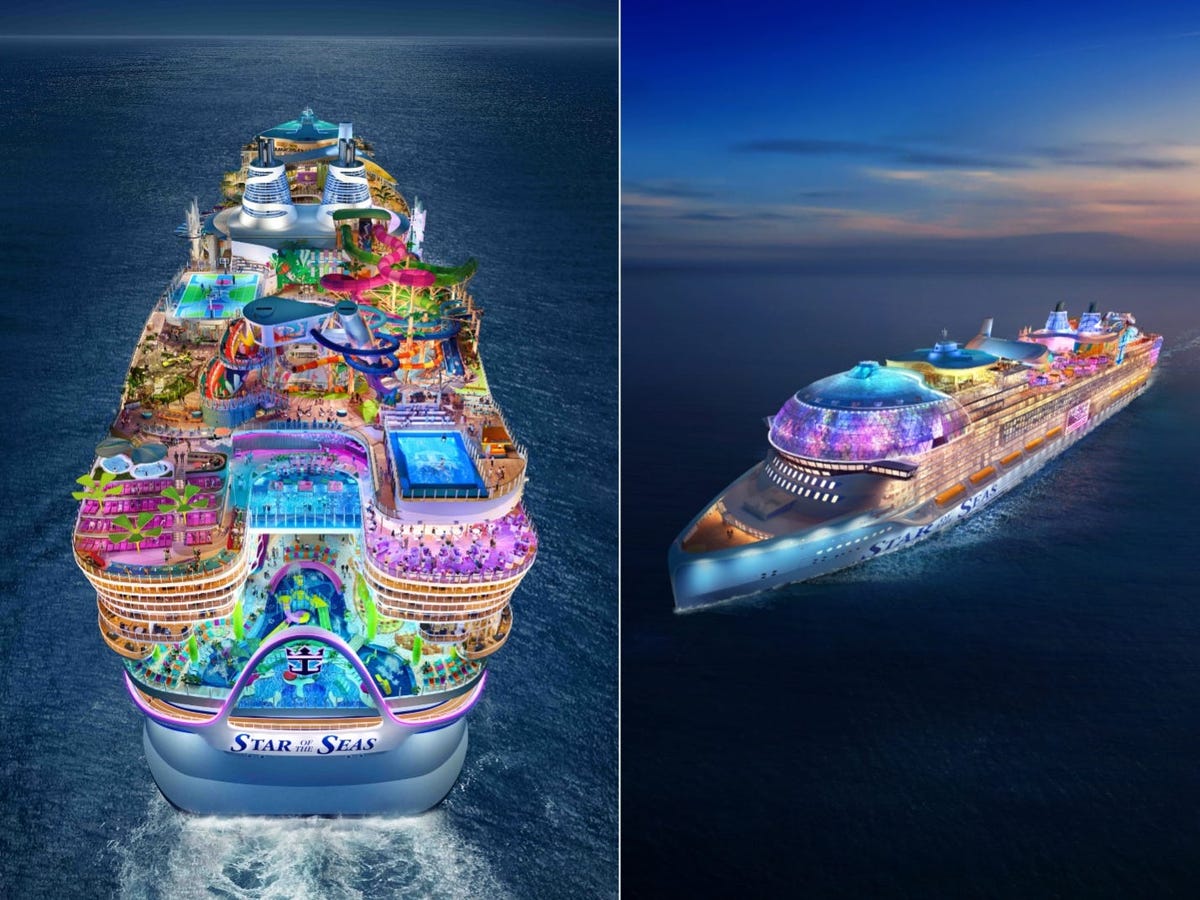
Compared to these leviathans Viking's ships are pipsqueaks. While we were moored behind Costa Toscana Viking Jupiter started her sail-away; the linked video actually shows Viking Jupiter leaving port. The hooting you hear in the clip is Viking Sea saluting Viking Jupiter as she passes, and vice versa.
That first night on board we ate dinner in one of the "alternative" restaurants, the "Captain's Table." These places require reservations, so we were very smart and locked down a table as soon as we boarded because if you wait too long you're out of luck. The Captain His-Self, despite the name, was not in evidence. The meal included very good lamb chops. Then, as seems to be true of all passenger ships, Viking Sea offers on-board entertainment so that first night it was something entitled "Rumba Catalan," a pallid imitation of what we'd seen at the Palace of Music; slightly boring, in fact. It included some jokey singers—I don't speak Spanish so I don't know what the real Flamenco singers were saying, but I suspect they weren't telling jokes—and the detestable practice of "audience participation" in which the spectators in the—captive?—audience are urged to clap. On the whole it was pretty tacky. Back to our stateroom to listen to the Port Talk on the in-room TV, and so to bed.
Our first port call was Montserrat, where there is a Benedictine monastery. After a room-service breakfast we hoofed it down to a motor coach for an hour's ride to this place. Well, the coach ride was an hour: when we got there we had to transfer to a cog railway up one of the steepest slopes I've ever seen outside of the Swiss Alps.
Monks are supposed to take vows of poverty, but if these monks did you sure wouldn't know it from the place where they live. Nor from the Gift Shop(pe) selling all kinds of made-in-China junque nor the ice cream store, nor the restaurant, etc. not to mention the donations people leave in the boxes or to light a candle. I suppose it takes big Euros to keep the monastery running, but it's a heck of a business. Not in the same league as the Vatican, but not too shabby as a money-making enterprise. It's a fair bet they get kickbacks from the ticket sales on that cog railway, too.
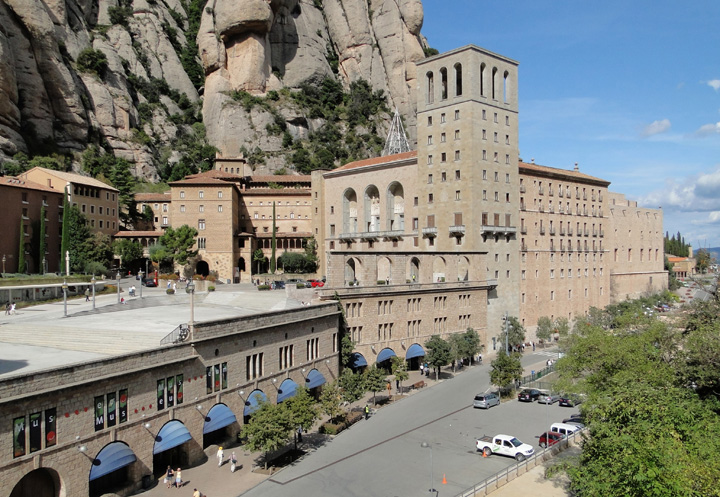
The monastery itself resembles a large apartment building, set into a hillside. There is—inevitably—a basilica, which houses a statue called "the black Madonna," the principal tourist attraction. It's a small statue, with people queued up for quite a length to shuffle past it. It's a "black" Madonna because it's carved out of some sort of very dark wood—ebony?—not for Politically Correct reasons. Innumerable souvenirs of this statue are available. I didn't see any "black Madonna" ice cream bars, but who knows?
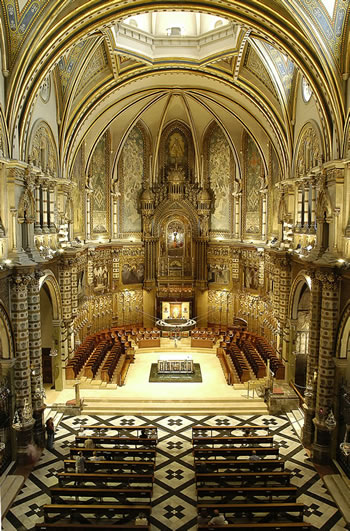
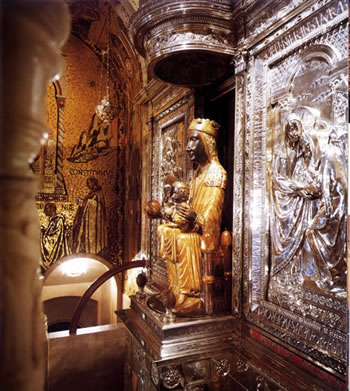
A Wine Tasting And A Pseudo-Medieval Village
Wine is a big deal with the kind of people who travel in Viking ships so there's always some sort of wine-tasting on offer in the shore excursions. We were taken to Domaine de Fregate, on a pretty rainy day. But the wine was good and "free" because it was part of the tour. The winery is near a so-called "medieval village," which is about as medieval as Disneyland, but pretty enough.
While we were wallowing in the fleshpots of Sainte-Cyr-sur-Mare the carpet in our stateroom was replaced. We thought this a bit odd, and asked why it was being done during a cruise. We were told that "small maintenance" was done when possible but "large maintenance" (such as, I suppose, scraping barnacles off the hull) required dry-docking. A ship in drydock isn't earning any money, of course. That night we managed to snaffle a table in Manfredi's, the Italian restaurant on board our ship. We had osso buco and returned to our freshly-carpeted stateroom.
An Old US Naval Base And A City Of Millionaires
The next day we were up at 5:00 AM for an excursion to Villefranche-sur-Mer, a beautiful spot that used to be the home port of the US Navy's Sixth Fleet. The port isn't deep enough for the Viking ships, so we went ashore from a tender. (How did Navy vessels dock there?) That must have been one fine duty station for sailors, a strong incentive for them to re-enlist! The Mediterranean beaches right there, a short trip to Monaco, the delights of the French Riviera right at hand and a brief train ride to Paris on a three-day pass. Alas the Navy no longer keeps ships there, much to the chagrin of the sailors and the local economy.
The real goal of this excursion was to see Monaco. This must be one of the strangest "countries" in the world. All of 512 acres (yes, acres, not square miles) in size, it has a population of about 38,000 people. All of them are millionaires who are in essence living in each others' pockets. About a third of them are "Monagasques," i.e., citizens. I have no idea what the rest may be. If you want an apartment there, be prepared to spend € 100,000 per square foot for the privilege.
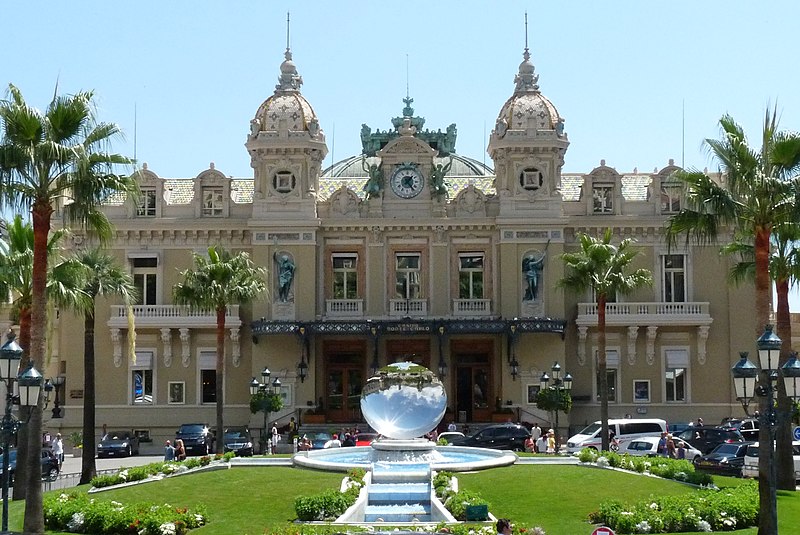
Monaco is not only the home of the Monte Carlo Casino immortalized in James Bond movies, it's a tax haven and an international center for money-laundering.
In 1956 the beautiful American actress Grace Kelly married Prince Rainier of Monaco thereby becoming "Princess Grace." She died in 1982 in an automobile crash. Her name and image are everywhere in that 512 acres. It seems that everything is named "Princess Grace This: or "Princess Grace That." Parks, gardens, buildings, you name it.
I think perhaps another reason Monaco is so rich is that it's the home to innumerable tsotchke shops selling souvenirs not one of which is made in Monaco, because other than the Casino, money laundering, and the annual Grand Prix automobile race, Monaco has no industries whatever.
The next day we were scheduled to go to Florence. Years ago we had been there and eaten a wonderful meal in a restaurant called Cibreo: getting a reservation there can take up to a year. Six months before we left I'd very cleverly made a reservation. But on returning to the ship I got a message that my reservation was cancelled! I'm still not sure why but I think there was some minor festival going on. Phooey. That was one of the "bucket list" items for this trip and I was denied it.
Florence
Viking has "included" excursions at every port. Some are guided but in some cases you can just go off, have a good time, and return to the ship before it sails. Since we'd been to Florence at least twice before we opted for "Florence On Your Own," on a grey, wet, nasty day. We were bused in; on the trip into town the guide went on a rant about food (this has happened before on other trips). His schtick was about how Bertolli olive oil and Barilla pasta were "poisoned" and we should avoid them at all costs unless we wanted to die. I'm not sure where that came from, or what his beef was, but it was bizarre to say the least. He also insisted on our not saying "Florence," because that's not the name: we were to call it "Firenze" and nothing else.
We walked around to various places: oh, how we walked. All day we walked. My feet, by the end of that day, hurt worse than they did in Basic Training. But we did see many beautiful sites, of which there's an abundance in Florence. We declined the three-hour wait to get into the Uffizi gallery, but we did visit the Basilica Santa Croce. Many very famous and important people are entombed there, including Michelangelo Buonarotti and Galileo Galilei.
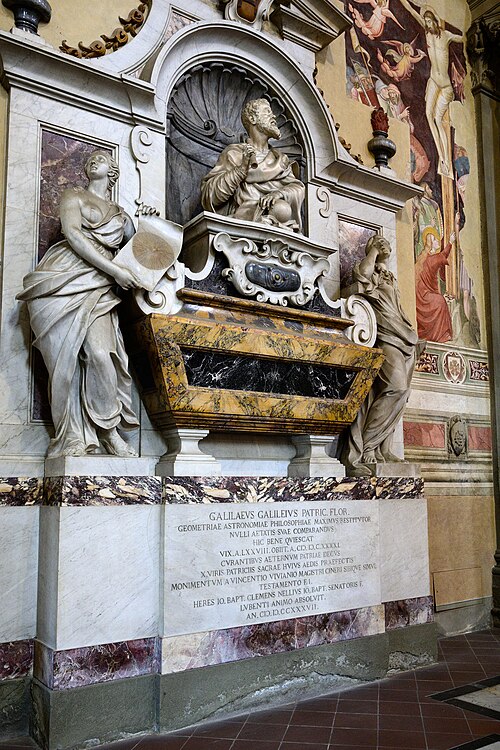
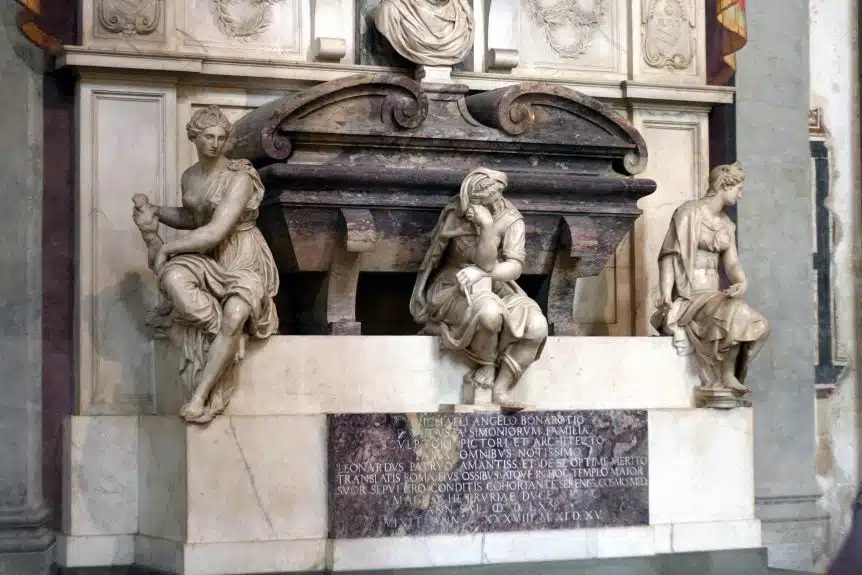
Two disappointing things about this day were that we docked in Livorno, a two-hour bus ride each way, which ate up a lot of the day. Then there was the graffiti: it was absolutely everywhere. This has regrettably become the norm in all large cities in Europe and the USA. It's a plague, a cancer, that seems unstoppable.
Rome And Ostia
The next stop was Rome. We'd been there twice so we'd seen all the "must see" places. Plus Rome is, even in the "off" season, infested wall-to-wall with tourists. We have heard that it takes a reservation to get to the Trevi Fountain these days, and that the authorities have issued edicts about controlling access to the Spanish Steps and the Piazza Navona. We opted for something else.
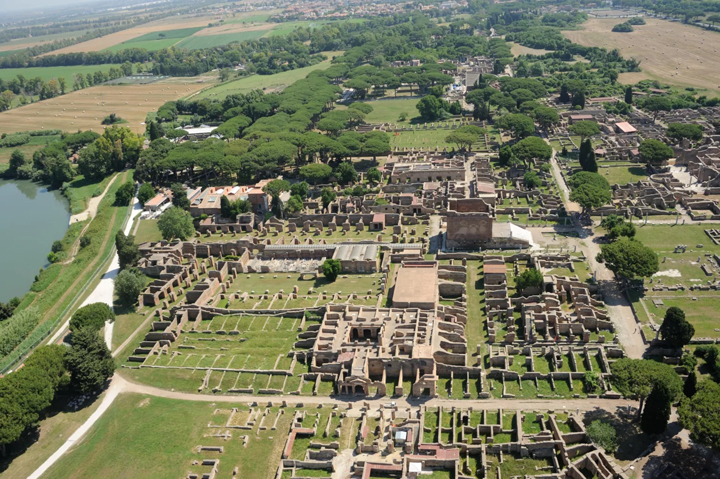
One of the included tours Viking had at this point was Ostia Antica. Ostia was the seaport of ancient Rome; it was located at the mouth of the Tiber river so that ships could unload cargoes onto barges, to be taken to the Imperial City. The Tiber has silted up the old site and it's now a couple of kilometers inland. But it's still there, and well worth seeing. Since most people have never heard of Ostia we figured it wouldn't be crowded and we were right. That was one of the best tours we took.
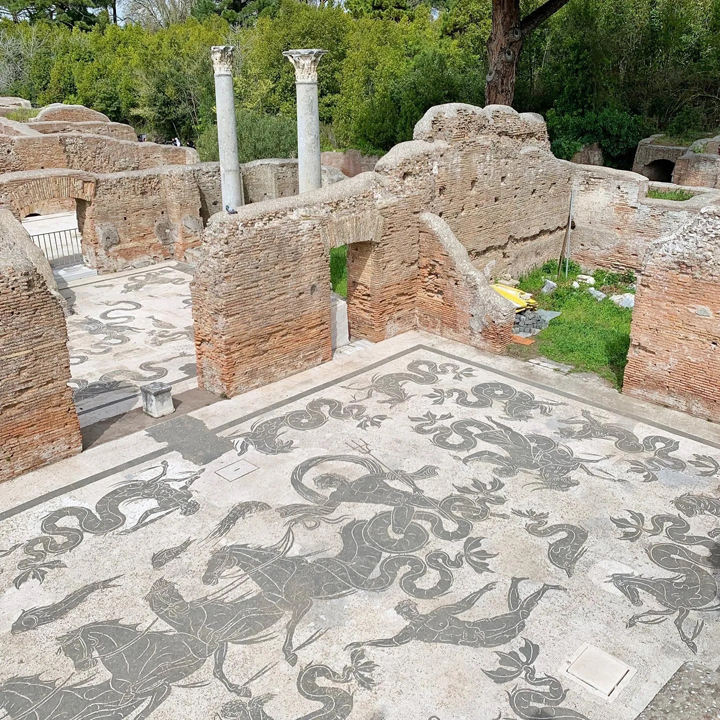
Unlike Rome, which was a government city, Ostia was a commercial one: there were customs houses (above), brokerages, ship chandlers, and many other businesses to support the import/export functions. This in addition to the apartment blocks (insulae), baths, a theater, and all the other amenities of an Imperial Roman city. Although Ostia is a ruin today, from which the marble cladding of the buildings was long ago removed and transported to Rome for use in Imperial buildings, it's still a very interesting place. We had an outstanding guide, a man who really knew his stuff, who explained everything we saw in sufficient but not too exhaustive detail. It was a beautiful day, and there were no crowds with which to contend. A real break from some of the other places we visited.
Naples
The next day was Easter Sunday. Many years ago we'd gone to see Pompeii and were tremendously disappointed. The weather was ghastly, there were no maps, no guides, so we saw nothing but sodden rocks. We'd wanted to visit Herculaneum (the other city devastated in AD 79 by the eruption of Mount Vesuvius) but passed it due to the foul weather. This time we didn't. It was also deeply interesting and what has been excavated was pretty well preserved. The crowds were moderate, easily manageable, plus our guide was knowledgeable about what we were seeing. It was a half-day tour: after lunch aboard the ship (roast sucking pig!) we hit the mean streets of Naples.
I do mean "mean" streets. Naples is pretty much a madhouse as we saw it. Last time we'd been there we were shocked at the dirt, the graffiti, the crowded streets with insane traffic, the Museum, holding priceless paintings, whose windows were open to the dusty streets and construction sites next to it, the general surliness of the people. Nothing much seems to have changed. The streets are very narrow, crowded, and full of souvenir stands and eateries. This does not stop the Neapolitan drivers from zooming up and down, threatening the lives and limbs of pedestrians. We were not impressed.
Taormina
Our ship docked in Messina Harbor. We were last in Messina in 2006, when I had a professional meeting there. The picture of a proud fishermen below was taken then. At that time you could stand on the wharf: no more. Today the security is tight, you can't get down to the water any longer, and I suppose that man has to find somewhere else to catch his anchovies.
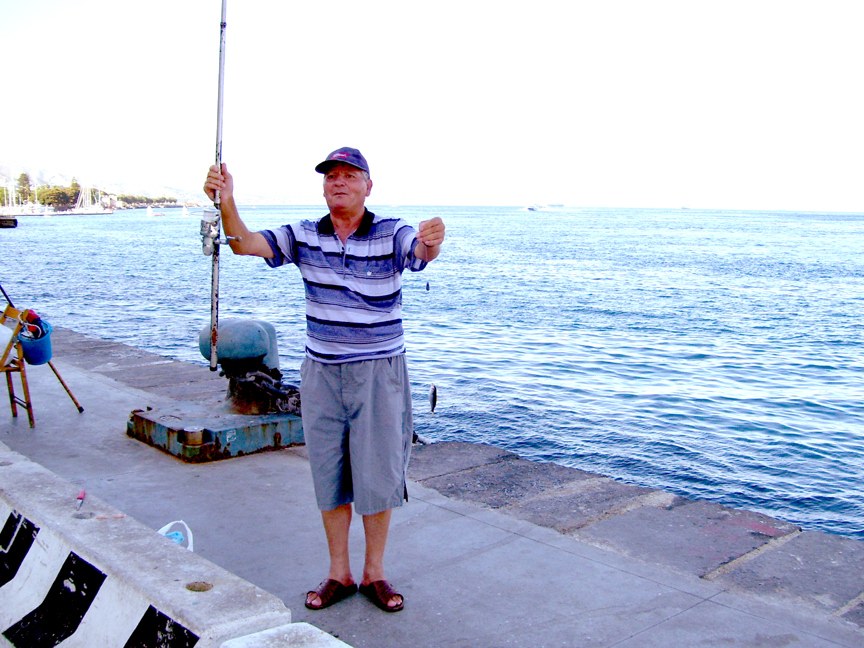
We were in for another hour on the bus (each way) to get to and from Taormina. Along the way we saw Mt Etna steaming. That's the most active volcano in Europe: last time we saw an actual eruption with red-hot lava but this trip it was just steam and smoke.
Taormina was very crowded. We walked from one end of the main street to the other end and back. Last time we'd been able to see the amphitheater but this trip there's a stiff admission charge (€ 14 each) so we passed. Thanks to my misunderstanding the directions given by our guide we were 10 minutes late getting back to the bus (I'm sure he was having fits about possibly losing a pair of tourists) but we made it in time.
A Sea Day
After all this sight-seeing and tramping around we had a "sea day," i.e., one in which we stayed on board as Viking Sea plowed the sea to our next stop, Heraklion in Crete. This was a welcome respite. I had a much-needed massage in the ship's spa, but we didn't just waste our time doing nothing. No siree. Viking has a "Future Sales" desk on board every ship. So we signed up for two more cruises.
Crete And Heraklion
I suppose it's not fair to judge a place based on a few hours' time, but we were very disappointed in Heraklion. There were large crowds, thus innumerable souvenir sellers. Not much of what they sold was locally made: like everything else these days most of it was made in China. We did visit an archeological museum. Our guide was a very knowledgeable (too knowledgeable) lady who shepherded us from one exhibit to the next rapidly. Quite frankly unless you're a specialist in this sort of thing it all looks the same: obviously she was a specialist, but we ignoranti couldn't grasp the subtle differences between ancient Minoan and later Cretan civilizations. She could have hit the highlights but she didn't. After that we made it back to the ship for a fine dinner of lamb shanks and baklava, and on to the last port of call, Piraeus, the port of Athens.
Athens...We Didn't See It
We had a plane to catch, to get back to London in time to board QM2 for the trip home.
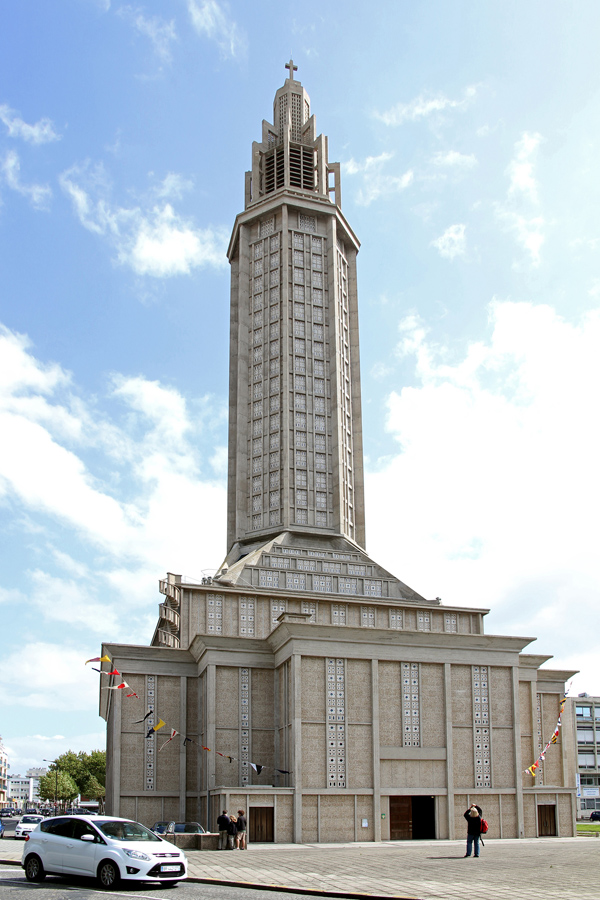 Home Again, Home Again
Home Again, Home Again
A train trip to Southampton and the next day we boarded. We spent an hour and a half doing the Security Rope Dance (up and down, up and down, up and down) but got there in the end. The return trip included a day in Le Havre: a very pleasant place, especially with the gorgeous weather. We walked to the beach, where we witnessed a traffic accident. A girl riding a bicycle was slammed by a car and injured.
Le Havre, as a seaside town not far from Southampton (Britain's major port in the Western Approaches) was home to German naval and air forces during the Second World War. Southampton was very hard hit by the Luftwaffe in 1940 because not only was it a port, it was the place of manufacture of the Supermarine Spitfire aircraft, the plane that essentially won the Battle of Britain.
In retaliation the Royal Air Force pretty much flattened Le Havre. Saint Joseph's Church, a post-war building commemorated the destruction with a moving display showing the extent of the damage.
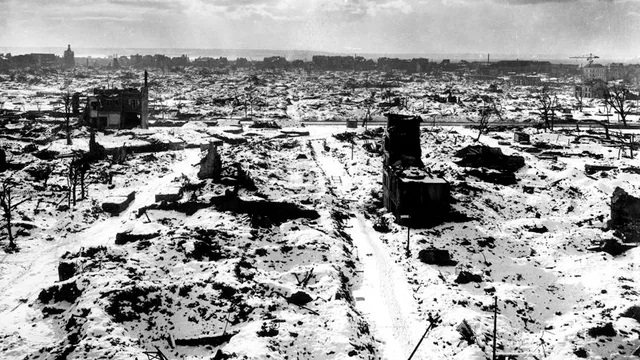
We had a memorable meal in Le Havre. I love oysters so I was delighted to find a restaurant that served them at very reasonable prices. Had I not had a ship to catch I'd likely still be there.
One interesting thing we found out was that many people who sail in QM2 westbound actually board in Le Havre, not Southampton. They come from Paris to do this because the processing is much faster and easier. Something to bear in mind next time!
The trip back was excellent as usual. We sailed late due to the tides. A couple of lectures on astronomy, a classical pianist, a couple of nice Yorkshire girls at lunch and a pair of architects at our table for dinner. The next night was one of Cunard's "Gala" nights. "Gala" nights are held in the large Queen's Ballroom. We don't dance but enjoy watching other people do it. The next day we attended a lecture or two (one on Ellis island, of all places) saw a very funny comedian, had a venison dinner and spent a few hours in the "Chart Room," QM2 's jazz lounge, our favorite place in the ship.
I had hoped to do an extensive tour of the ship, but I had a horrendous cough so we cancelled that. We saw a performance by an overwhelmingly self-aggrandizing singer and later a really entertaining performance of traditional Irish music by the "Blackthorn Duo." A couple of other performances including a man who bills himself as "The World's Fastest Violinist," and a pianist who played Gershwin and Cole Porter.
Late in this voyage we discovered the "Commodore Club" lounge and I wish we'd known about it earlier. The ship has a wonderful library with windows facing out over the bow, giving exceptional views. Alas, everyone knows about the library: getting a seat at one of those windows is nearly impossible unless you're there as soon as the doors opens, and maybe not then. However, the Commodore's Club is on the next deck up; it too has such windows. It's far less known so we were able to get seats to watch the sea.
We landed the next day. Spent a night in a hotel, thence to AMTRAK for the trip back. We left Penn Station on time but were held up outside Baltimore by a "Trespasser strike" (i.e., someone got killed trying to cross the tracks to beat the train). This put us at least 2 hours behind schedule. In time we made it back, and were grateful to return.
| HUNTING | GUNS | DOGS |
| FISHING & BOATING | TRIP REPORTS | MISCELLANEOUS ESSAYS |
| CONTRIBUTIONS FROM OTHER WRITERS|
| RECIPES |POLITICS |
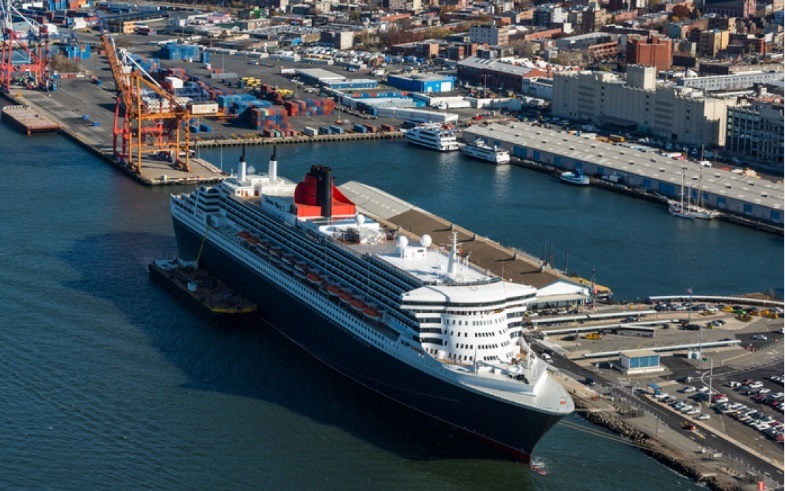







 The security people are incredibly strict. I routinely carry a small pocket knife, but I'm not crazy enough to carry it onto an airplane in my pocket, so I stick it into my checked bag. On airlines this works well, but the security guy at St Pancras spotted it on an X-ray, and said to me, with a menacing tone, "Do you have a
The security people are incredibly strict. I routinely carry a small pocket knife, but I'm not crazy enough to carry it onto an airplane in my pocket, so I stick it into my checked bag. On airlines this works well, but the security guy at St Pancras spotted it on an X-ray, and said to me, with a menacing tone, "Do you have a 

 was a Godsend. We dropped off our clothes ("Non self-service, Monsieur !") and were able to pick them up the next day.
was a Godsend. We dropped off our clothes ("Non self-service, Monsieur !") and were able to pick them up the next day. 

 When you go to Europe you visit cathedrals. We have visited so many cathedrals I've long since lost count, but the Basilica Sagrada Familia takes the cake. It is, without doubt, the ugliest cathedral—heck, the ugliest building—I have ever seen, and am ever likely to see.
When you go to Europe you visit cathedrals. We have visited so many cathedrals I've long since lost count, but the Basilica Sagrada Familia takes the cake. It is, without doubt, the ugliest cathedral—heck, the ugliest building—I have ever seen, and am ever likely to see.

















 Home Again, Home Again
Home Again, Home Again